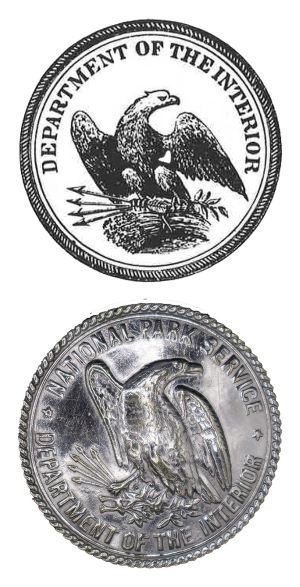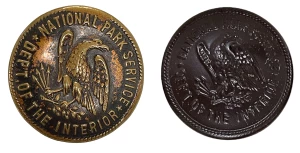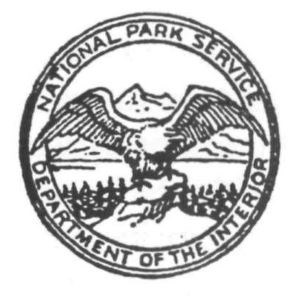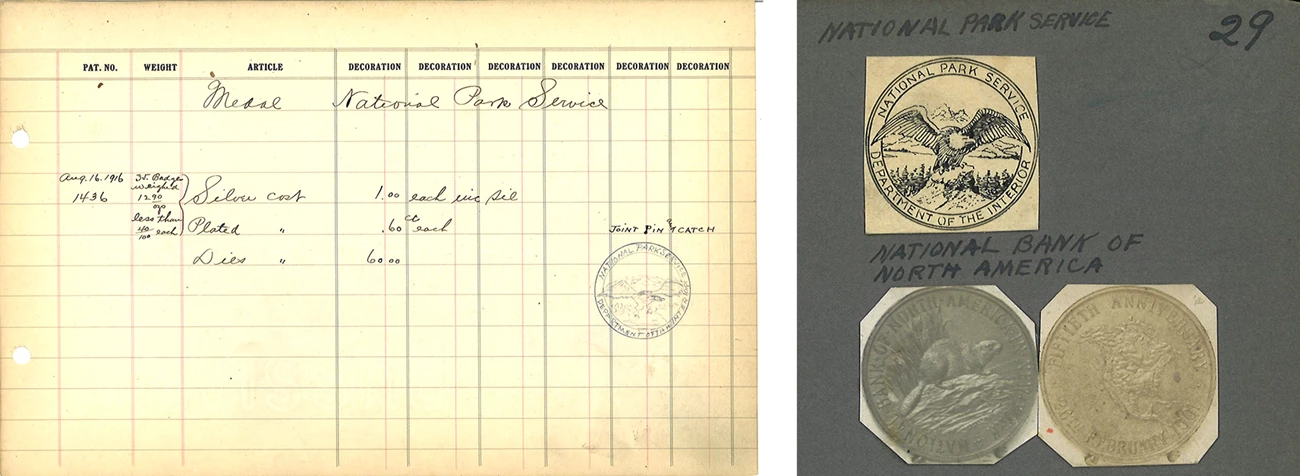Last updated: November 15, 2023
Article
50 Nifty Finds #36: Taking Flight
If asked about a symbol or emblem for national parks today, most visitors would probably envision the National Park Service (NPS) arrowhead or a bison. Although those iconic symbols have been associated with the NPS for over 70 years, they are not the first emblems of the fledgling NPS. In fact, if you know where to look, you can see the earliest symbol is still with us today.

The DOI Eagle
The US Department of the Interior (DOI) was created on March 3, 1849. That same year Edward Stabler of Sandy Springs, Maryland, was commissioned to create the first official seal. That circular design features an eagle with its wings spread looking to the left, clutching arrows, and perching on a sheaf of wheat. The words “Department of the Interior” within a rope design border encircle the eagle.
The original DOI seal was obviously the inspiration for the first DOI-issued badge created for park rangers in 1906, a decade before the NPS was officially created. The round, silver-plated badge continues the eagle motif, although the perspective is slightly different. Looking left, the bird clutches arrows, but two tree branches replaced the wheat. The words “National Park Service” were added, and the rope border was retained. Although the artist drew inspiration form Stabler’s seal, the designer of this DOI-issued badge is unknown.
The badges are rare today (the NPS History Collection only has one example). However, they weren't the only device to use that design. When the DOI authorized the first optional ranger uniform in 1911, it featured US Army buttons. The department was initially reluctant to spend the $28 to make a special die for park service buttons “until the future of the national park service is definitely determined. If the Bureau of National Parks is created, another design of button might be necessary.” They soon changed their position.
Around January 1912 Sigmund Eisner, president of the Sigmund Eisner uniform manufacturing company in Red Bank, New Jersey, met with DOI Chief Clerk Clement Ucker about the feasibility of creating uniform buttons based on the DOI-issued badge. Eisner created dies for the different sizes of buttons needed for the ranger uniform. In 1912 the company provided DOI with enameled bronze buttons bearing the eagle badge design. The buttons were made by the Waterbury Button Company of Waterford, Connecticut. The early buttons are stamped “Sigmund Eisner/Red Bank NJ” on the back. Later they would be stamped with both names and then only Waterbury's information. In the 1930s the button changed to an oxidized bronze finish.
Although the DOI-issued badge was replaced after the NPS was established in 1916, the buttons are still part of the uniform today. They remain an important link from today's NPS employees to rangers of the past.


The First NPS Emblem
Given the use of the eagle in the DOI seal, it's not surprising that the NPS also used an eagle in its first emblem. Like the DOI-issued badge, this symbol predates the creation of the NPS on August 25, 1916, but has a long history within the bureau.
In 1916 Stephen T. Mather (then special assistant to the secretary of Interior but soon to be the first NPS director) hired Robert Sterling Yard to produce a book to increase park tourism and encourage popular and political support for a parks bureau to manage the national parks and monuments. Titled National Parks Portfolio, it was a series of nine pamphlets about national parks. It was published in June 1916, two months before the NPS was established. A drawing of a new NPS eagle emblem was printed on the back cover.
The circular design features an eagle perched on a rock with its winds spread wide as it looks to its left. A forest is seen below with mountains in the background. The words "National Park Service" and "Department of the Interior" run around a narrow band at the edge of the circle. The artist who designed and drew the eagle emblem is unknown, but it is safe to assume that Mather and probably Yard were involved in the design concept. Although no documentation has been found, it seems impossible that Mather didn't discuss it with and seek approval from the secretary of the Interior prior to publishing it.
Interestingly, the National Parks Portfolio is the only known example of print materials where this NPS eagle emblem was used. No documentation explaining that has been found. However, given that the DOI seal changed in 1917 from the eagle to a bison it seems reasonable to assume it was abandoned to avoid inconsistencies with DOI's new emblem. When the 1917 edition of the portfolio was published—the first official publication of the brand new NPS—the eagle emblem wasn't included. Subsequent print publications featured the DOI seal only until the 1950s.

Until recently it was thought that the eagle emblem was used on the National Parks Portfolio and set aside until the NPS issued its first badge in 1920, and it became the center of the new shield-shaped badge. New research and evidence from the Tiffany Archives, however, shows that the first NPS-issued ranger badge was designed in 1916 and featured this same design.
Discovery of these materials in the Tiffany Archives confirms the design of small round badges seen in photographs from 1917 and 1918. Their design book leaves no doubt that the image on this badge and in the National Parks Portfolio are the same. It also fills a logic gap in the previous thinking that saw the new NPS wait three years to issue its own ranger badge and unexpectedly choose an emblem used only once in 1916 as the central image. It is likely that badges with this emblem were first received in 1917 (the NPS didn't get its first budget until April of that year) and were used until 1920 when the new shield-shaped badge was issued. Due to badge shortages in the field, some rangers continued to wear the DOI-issued badges into the early 1920s.
This round eagle badge (in silver and gold versions) was used again from 1921 to 1960 as a badge for directors, superintendents, and other officers to distinguish them from rangers. Badges with this symbol were used until 1968. Although the eagle emblem was short-lived on print materials, it remained part of NPS identity for over 50 years.

Copyright Tiffany Archives 2023. (Not to be published or reproduced without prior permission. No permission for commercial use will be granted except by written license agreement.)
Sources:
Assembled Historic Records of the NPS (HFCA 1645). NPS History Collection, Harpers Ferry, WV.
Workman, R. Bryce. (1991). National Park Service Uniforms: Badges and Insignia. Harpers Ferry Center, Harpers Ferry, WV.
